“A lot of people don’t realise how influential Lovecraft was until they start reading his works” Lyndon White on the The Call of Cthulu, The Mind of James Svengal, and more!

It takes a lot to stand out from the crowd in the world of indie horror comics, but one artist who is really starting to make waves for himself is Lyndon White. Whether it is via his creator owned work like The Mind of James Svengla, or the recent Mandy The Monster Hunter series The Spindly Man, White’s unique mixed media style has a real uniqueness to it, which is set to be further showcased via a concertina Cthulu Collection, which is currently funding on Kickstarter. We caught up with the man himself to find out more.
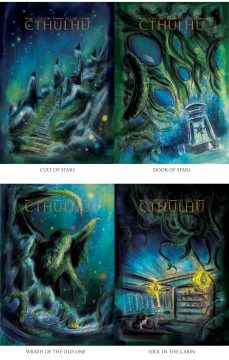 You have just launched a kickstarter for a new book based around Cthulu, can you tell us a bit about it and why it is so unique? The gatefold cover certainly feels pretty special
You have just launched a kickstarter for a new book based around Cthulu, can you tell us a bit about it and why it is so unique? The gatefold cover certainly feels pretty special
Lyndon White: The book is an adaption of H.P. Lovecraft’s short story The Call of Cthulhu in the form of a concertina book, which is a small fold out art book. You can read it as a normal book or fold it out and display it as a long piece of artwork. With concertinas you are limited to a page count of 10 images (9 if you don’t include the back cover), which challenges you to tell a story in a limited amount of single images. All of which is very different to my usual work which is comics, where you can break down stories and key scenes into multiple images which speech bubbles etc.
This version of Lovecraft’s story is my interpretation of The Call of Cthulhu, how I visualise and see it in my head. It’s one of Lovecraft’s more commonly adapted stories so there will be some familiar imagery to hard-core Lovecraft fans but after seeing multiple adaptions, I found a lot of them tend to rush towards the ending where (spoiler alert) Cthulhu shows up. Which is to be expected, the story is after all named after him, but those adaptions miss out key parts of the narrative and the parts which make it a great Lovecraft story. So my version of Cthulhu covers the beginning, middle and end of the story, with the slow build up and mystery of Cthulhu and the cult that follows him.
What do you think the enduring popularity of Lovecraft is all about?
LW: I think its down to his visualisation of the world and the strength of his stories. A lot of people don’t realise how influential he was until they start reading his works and then noticing how other storytellers been inspired by him. Lovecraft naturally slips into the work of a lot of writers and artist. Not in a sense they copy from him, but you can look at the artwork or read the story and think, yes this person likes Lovecraft.
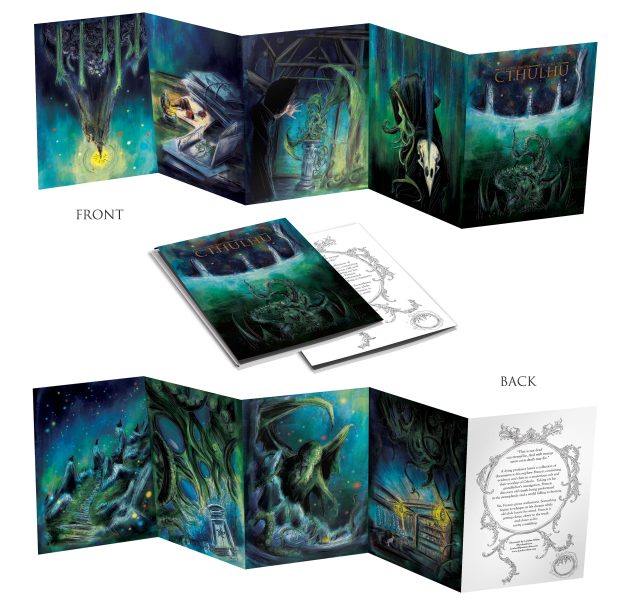
It’s in a similar format to a previous Dracula book you released, can you tell us a bit about how that came about, and what the response was like? I assume good if you are revisiting the format! Have you got any plans to develop any other horror franchises in this way?
LW: The starting point for these concertina books was from a Dracula illustration that I did roughly 2 years ago now. It was my version of a Dracula book cover. While I was on the comic con circuit and exhibiting at art shows I sold it as prints and wherever I went people would very excitedly ask “Your doing Dracula?”, “You need to do more of this!”, “Is it for a comic?”, “I can’t wait for the book” etc. In truth, there was no book. The illustration was for fun in my downtime. I actually doodled the thumbnail for it while I was waiting for another painting to dry.
So from all this I knew I wanted to adapt more of Dracula however I was already committed to other projects that I’d signed up to and doing it as a full sized graphic novel would probably take at least 1-2 years to do properly (its bigger than most people remember), plus its already been adapted in multiple ways. So I settled on a smaller scaled project in the form of a concertina and making one of these types of books was already on my bucket list. I worked on the artwork in my evenings and spare time. Got it all finished and took it to Kickstarter on the 14th March 2017. I really wasn’t sure how it was going to go so I set a target of £600 to cover the printing costs. By the time the Kickstarter was finished I did multiple stretch goals, got to make a second concertina adapting Dante’s Inferno and raised £4,692.
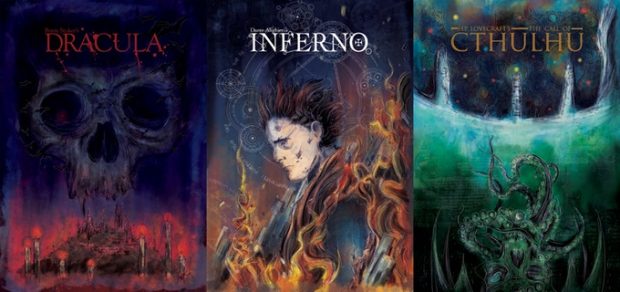
While the Kickstarter was running I was working on Dante’s Inferno and even after finishing that book people were asking for more concertinas and adaptions. Lovecraft was heavily requested but I couldn’t commit the time to it then, so I’m back a year later with a Lovecraft story.
This time round I’m still starting with a low target. If people like the book, back the project and help the Kickstarter grow, there’s room for other adaptions but the demand needs to be there. I feel there’s only so many concertina books that a single person wants to own, so I don’t want to over do it. I’d prefer these books to feel special and not disposable.
You seem to have had a very busy 12 months with lots of other great projects you’ve been involved with, are they just all coming to fruition about now or has it been a busy period?
LW: As a lot of people who know me and know my work ethic, I’m usually pretty busy. Which is amazing. I work as a full time freelancer so being busy is never a bad thing. A few projects have gotten shuffled round and as a result some released very close to one another. I tend to finish a project a few months before its release date and then its down to the publisher when they hit the go button. For example I finished a book for Blue Fox last year and it probably wont be out for another few months. Which is fine because I’m always working a few months in advance so if delays or set backs happen, there’s time to adjust for it.
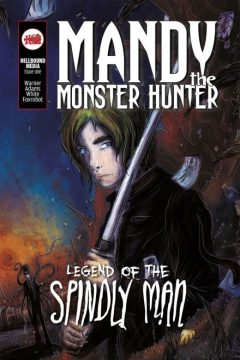
2017 was a very good year for me. I did a bunch of work for Comichaus with the final issue due out around now. I finished my graphic novel The Mind of James Svengal and took is to Kickstarter which was a big book and a long time scale project. Blue Fox Comics had me working on a bunch of stuff doing interiors, lettering, covers, book design, logos etc. I started a new Mandy the Monster Mini-Series for Hellbound Media. Overall, 2017 was mostly about finishing projects and work commitments. It was a busy year.
One of our favourites is your recent involvement with Hellbound Media, how did that come about and what was it about Mandy the Monster Hunster and more importantly the Spindly Man who enticed you in to work on this project? (Your artwork certainly gives the book a really interesting and unique dynamic which we love!) Did they approach you and did you develop the character together?
LW: Hellbound Media approached me roughly a year ago after reading Hexes: Waking Nightmare from Blue Fox Comics (I did the artwork and lettering). They loved that book and thought I’d be perfect for a Mandy story which has become one of their biggest Mandy stories to date. I liked the idea of working with an already established character and getting to work with horror but with a bit more action with the mystery elements. Hellbound were already developing the story and I did some sketches of Mandy, Spindly and a few other established Mandy characters to get their “look” right. Thankfully, they were very trusting and encouraged me to put my own spin on what had been done before. Once the sketches were approved I got to work on the comic and sometimes we make slight changes in the rough stage (which is to be expected in comics) but working with them has been pretty easy. They are very trusting in me.
It’s also great to play around with imagery inspired by Slender Man. The long limbs and creepy almost blank face creates a lot of character and atmosphere even in the pencils.
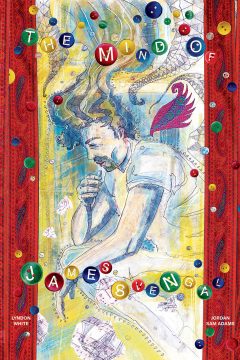 You also published your latest graphic novel The Mind of James Svengal about an artist struggling with mental health – was this a particularly close subject to you? And an important tale to tell?
You also published your latest graphic novel The Mind of James Svengal about an artist struggling with mental health – was this a particularly close subject to you? And an important tale to tell?
LW: The Mind of James Svengal has been something I’ve been working on with Jordan Sam Adams for a few years now. Original we had a publisher but our and a number of other projects in development got axed overnight. Which sucks, but it does happen every now and again in publishing. When this happened we were well into development and not wanting to waste all the work already done we pushed forward and ended up doing it all ourselves.
With the book tackling mental health and the struggle James goes through, it was pretty close to myself and Jordan. The book isn’t autobiographic, but is directly influenced by mine and Jordan’s experiences. There are other mental healthy style graphic novels out there but we wanted to focus on the harsh self destructiveness that can come with it (please note, that is now always the case, everyone is different), but as we said in our Kickstarter video, we wouldn’t have done this kind of story if we hadn’t collectively been through it. It was important for us to do a gritty yet surreal version of that subject as mental health often gets bastardized or glamorized when used as part of a story, particularly in film.
You have a really unique style to your art with the white lines over the top of your colours, can you give us a bit of insight into your process? How did you come up with this unique approach?
LW: The white lines are a throw back to when I used to do big canvas paintings. There’s a technique where you scratch into the paint once the paint has dried and you use it to highlight or define parts of your painting (or at least that’s what I used to do). Now I work half traditionally and half digitally. I’m actually partly colour blind so working traditionally can sometimes become difficult because I can’t keep track of what colours I’m mixing. So now I do all the line work and inking by hand in greyscale and then paint colours in digitally. Its a similar method I used to do but I have more control over the colours and I can keep track of which colour is which. The digital painting aspect hasn’t really changed as I use digital brushes that act like acrylic or oils, so its similar but a bit more controlled and editable.
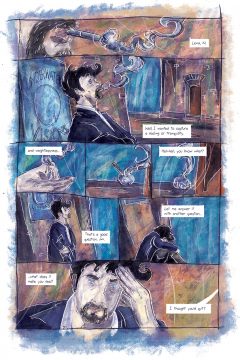 And what about your influences? Who or which comics inspired you to get into comics?
And what about your influences? Who or which comics inspired you to get into comics?
LW: We have Dave Mckean to blame for getting me into the game. I’d made some comics in college before I came across his work but I didn’t release the scope of the medium or the fact it was someone’s job to make this stuff. Then someone handed me a copy of Arkham Asylum: A Serious House on Series Earth and that was it. I was in for the long haul. I love Mckean’s work and most people can probably tell when they look at my stuff. Once I found McKean, I came across Sienkiewicz, Jeff Smith, Allen Moore, Neil Gaiman, Derek Hess, Russ Mills, Ben Templesmith etc, basically all the hits. Since I was in college I absorbed everything like a sponge. I’m not particular bothered about genre (he says after spending most of last year drawing Horror comics), but as long as there’s a good story, I’m in.
And finally, what’s next? More Mandy or more personal projects?
LW: In terms of long scale projects, I’ve cleaned my work slate as much as possible so that I can pitch some new stuff. A position I’ve not been in for about 2 years as I’ve been booked up. So while I work on Mandy #2-4 I’m pitching. Some things completely my own, some with other creators. One pitch is already sent off and I’m currently developing another. There’s a couple of things going on in the background but nothing ready to mention yet.
Cthulhu and Mandy are going to be giving people their horror fix from me for awhile. So I will be able to venture out again and mix things up a bit. Svengal is a very different book compared to the other books I worked on last year, people can expect me to be dipping into different pools.
You can back Lyndon’s Call of Cthulu campaign on Kickstarter here



October 8, 2025 @ 6:49 pm
I appreciate the effort put into this post. Catch dubai racing tv live today — odds, racecards, and results. clear commentary and analysis. stats and timings, post‑race interviews, track conditions. Including today’s schedule. clear commentary and analysis.